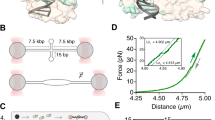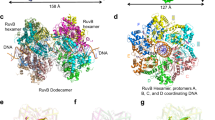Abstract
Holliday junctions (HJs) are key intermediates in homologous recombination and are especially important for the production of crossover recombinants1,2,3,4. Bacterial RecA family proteins promote the formation and branch migration of HJs in vitro by catalysing a reciprocal DNA-strand exchange reaction between two duplex DNA molecules, one of which contains a single-stranded DNA region that is essential for initial nucleoprotein filament formation5. This activity has been reported only for prokaryotic RecA family recombinases5, although eukaryotic homologues are also essential for HJ production in vivo6,7. Here we show that fission yeast (Rhp51) and human (hRad51) RecA homologues promote duplex–duplex DNA-strand exchange in vitro. As with RecA, a HJ is formed between the two duplex DNA molecules, and reciprocal strand exchange proceeds through branch migration of the HJ. In contrast to RecA, however, strand exchange mediated by eukaryotic recombinases proceeds in the 3′→5′ direction relative to the single-stranded DNA region of the substrate DNA. The opposite polarity of Rhp51 makes it especially suitable for the repair of DNA double-strand breaks, whose repair is initiated at the processed ends of breaks that have protruding 3′ termini1,2.
This is a preview of subscription content, access via your institution
Access options
Subscribe to this journal
Receive 51 print issues and online access
$199.00 per year
only $3.90 per issue
Buy this article
- Purchase on Springer Link
- Instant access to full article PDF
Prices may be subject to local taxes which are calculated during checkout




Similar content being viewed by others
References
Pâques, F. & Haber, J. E. Multiple pathways of recombination induced by double-strand breaks in Saccharomyces cerevisiae. Microbiol. Mol. Biol. Rev. 63, 349–404 (1999)
Symington, L. S. Role of RAD52 epistasis group genes in homologous recombination and double-strand break repair. Microbiol. Mol. Biol. Rev. 66, 630–670 (2002)
Bishop, D. K. & Zickler, D. Early decision; meiotic crossover interference prior to stable strand exchange and synapsis. Cell 117, 9–15 (2004)
Cromie, G. A. et al. Single Holliday junctions are intermediates of meiotic recombination. Cell 127, 1167–1178 (2006)
Cox, M. M. Motoring along with the bacterial RecA protein. Nature Rev. Mol. Cell Biol. 8, 127–138 (2007)
Schwacha, A. & Kleckner, N. Interhomolog bias during meiotic recombination: meiotic functions promote a highly differentiated interhomolog-only pathway. Cell 90, 1123–1135 (1997)
Hunter, N. & Kleckner, N. The single-end invasion: an asymmetric intermediate at the double-strand break to double-Holliday junction transition of meiotic recombination. Cell 106, 59–70 (2001)
Bianco, P. R., Tracy, R. B. & Kowalczykowski, S. C. DNA strand exchange proteins: a biochemical and physical comparison. Front. Biosci. 3, D570–D603 (1998)
Masson, J. Y. & West, S. C. The Rad51 and Dmc1 recombinases: a non-identical twin relationship. Trends Biochem. Sci. 26, 131–136 (2001)
Baumann, P. & West, S. C. Role of the human RAD51 protein in homologous recombination and double-stranded-break repair. Trends Biochem. Sci. 23, 247–251 (1998)
Haruta, N. et al. The Swi5–Sfr1 complex stimulates Rhp51/Rad51- and Dmc1-mediated DNA strand exchange in vitro. Nature Struct. Mol. Biol. 13, 823–830 (2006)
West, S. C., Cassuto, E. & Howard-Flanders, P. Postreplication repair in E. coli: strand exchange reactions of gapped DNA by RecA protein. Mol. Gen. Genet. 187, 209–217 (1982)
Chow, S. A., Chiu, S. K. & Wong, B. C. RecA protein-promoted homologous pairing and strand exchange between intact and partially single-stranded duplex DNA. J. Mol. Biol. 223, 79–93 (1992)
Haruta, N., Yu, X., Yang, S., Egelman, E. H. & Cox, M. M. A. DNA pairing-enhanced conformation of bacterial RecA proteins. J. Biol. Chem. 278, 52710–52723 (2003)
Shinagawa, H. & Iwasaki, H. Processing the Holliday junction in homologous recombination. Trends Biochem. Sci. 21, 107–111 (1996)
Dunderdale, H. J. et al. Formation and resolution of recombination intermediates by E. coli RecA and RuvC proteins. Nature 354, 506–510 (1991)
Haruta, N. et al. Fission yeast Swi5 protein, a novel DNA recombination mediator. DNA Repair (Amst.) 7, 1–9 (2008)
Shan, Q., Cox, M. M. & Inman, R. B. DNA strand exchange promoted by RecA K72R. Two reaction phases with different Mg2+ requirements. J. Biol. Chem. 271, 5712–5724 (1996)
Kim, J. I., Cox, M. M. & Inman, R. B. On the role of ATP hydrolysis in RecA protein-mediated DNA strand exchange. II. Four-strand exchanges. J. Biol. Chem. 267, 16444–16449 (1992)
Sung, P. & Robberson, D. L. DNA strand exchange mediated by a RAD51-ssDNA nucleoprotein filament with polarity opposite to that of RecA. Cell 82, 453–461 (1995)
Kmiec, E. B. & Holloman, W. K. Heteroduplex formation and polarity during strand transfer promoted by Ustilago rec1 protein. Cell 33, 857–864 (1983)
Namsaraev, E. & Berg, P. Characterization of strand exchange activity of yeast Rad51 protein. Mol. Cell. Biol. 17, 5359–5368 (1997)
Namsaraev, E. A. & Berg, P. Branch migration during Rad51-promoted strand exchange proceeds in either direction. Proc. Natl Acad. Sci. USA 95, 10477–10481 (1998)
Gupta, R. C., Golub, E. I., Wold, M. S. & Radding, C. M. Polarity of DNA strand exchange promoted by recombination proteins of the RecA family. Proc. Natl Acad. Sci. USA 95, 9843–9848 (1998)
Baumann, P. & West, S. C. Heteroduplex formation by human Rad51 protein: effects of DNA end-structure, hRP-A and hRad52. J. Mol. Biol. 291, 363–374 (1999)
Mazin, A. V., Zaitseva, E., Sung, P. & Kowalczykowski, S. C. Tailed duplex DNA is the preferred substrate for Rad51 protein-mediated homologous pairing. EMBO J. 19, 1148–1156 (2000)
Cox, M. M. & Lehman, I. R. Directionality and polarity in recA protein-promoted branch migration. Proc. Natl Acad. Sci. USA 78, 6018–6022 (1981)
Konforti, B. B. & Davis, R. W. 3′ homologous free ends are required for stable joint molecule formation by the RecA and single-stranded binding proteins of Escherichia coli. Proc. Natl Acad. Sci. USA 84, 690–694 (1987)
Jain, S. K., Cox, M. M. & Inman, R. B. On the role of ATP hydrolysis in RecA protein-mediated DNA strand exchange. III. Unidirectional branch migration and extensive hybrid DNA formation. J. Biol. Chem. 269, 20653–20661 (1994)
Bugreev, D. V., Mazina, O. M. & Mazin, A. V. Rad54 protein promotes branch migration of Holliday junctions. Nature 442, 590–593 (2006)
Constantinou, A. & West, S. C. Holliday junction branch migration and resolution assays. Methods Mol. Biol. 262, 239–253 (2004)
Lusetti, S. L. et al. C-terminal deletions of the Escherichia coli RecA protein. Characterization of in vivo and in vitro effects. J. Biol. Chem. 278, 16372–16380 (2003)
Yoshikawa, M., Iwasaki, H., Kinoshita, K. & Shinagawa, H. Two basic residues, Lys-107 and Lys-118, of RuvC resolvase are involved in critical contacts with the Holliday junction for its resolution. Genes Cells 5, 803–813 (2000)
Acknowledgements
We thank N. Haruta-Takahashi, T. Kokubo and K. Morikawa for discussions and encouragement, and T. Miyata for her help in electron microscopy sample preparation. This study was supported in part by Grants-in-Aid from the Ministry of Education, Culture, Sports, Science, and Technology (MECSST) of Japan and from the Japan Society for the Promotion of Science (JSPS), and by a grant from the 2007 Strategic Research Project of Yokohama City University.
Author Contributions Y.M., Y.K. and H.I. designed the experiments. Y.M. and Y.K. performed the experiments. K.M. performed the electron microscopy analysis. Y.M. and H.I. wrote the manuscript.
Author information
Authors and Affiliations
Corresponding author
Supplementary information
Supplementary Information
The file contains Supplementary Figures 1-10 with Legends. (PDF 1007 kb)
Rights and permissions
About this article
Cite this article
Murayama, Y., Kurokawa, Y., Mayanagi, K. et al. Formation and branch migration of Holliday junctions mediated by eukaryotic recombinases. Nature 451, 1018–1021 (2008). https://doi.org/10.1038/nature06609
Received:
Accepted:
Published:
Issue Date:
DOI: https://doi.org/10.1038/nature06609
This article is cited by
-
Coordination of cohesin and DNA replication observed with purified proteins
Nature (2024)
-
Enhanced homologous recombination by the modulation of targeting vector ends
Scientific Reports (2020)
-
Equilibrious Strand Exchange Promoted by DNA Conformational Switching
Scientific Reports (2013)
-
Human Rad51 mediated DNA unwinding is facilitated by conditions that favour Rad51-dsDNA aggregation
BMC Biochemistry (2009)
-
Cruciform-forming inverted repeats appear to have mediated many of the microinversions that distinguish the human and chimpanzee genomes
Chromosome Research (2009)
Comments
By submitting a comment you agree to abide by our Terms and Community Guidelines. If you find something abusive or that does not comply with our terms or guidelines please flag it as inappropriate.



